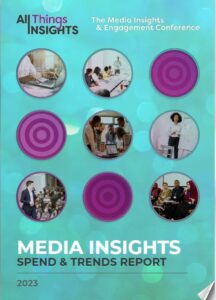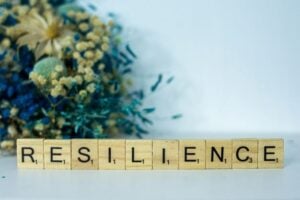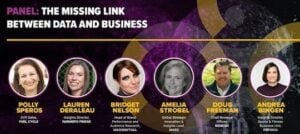In this year’s survey, the meaning of “influence” remained a key topic for respondents as well as guest contributors when examining the insights function. Answering the question, “What are the biggest strengths within the insights function in your organization?,”52% of those surveyed said “expanding influence on the business.” Only “understanding consumers” garnered more support, with 59% of respondents. In relation to expanding influence, strengths also included unique skillset (41%); working across departments (37%); and adaptability (30%). Some also selected speed of insights as a strength as well.
However, when listing the biggest weaknesses within the insights function, 40% of survey respondents noted the “lack of control over activation of insights” as the second biggest weakness. Only limited budget, time or resources rated higher, with 47% of respondents. Discounting the budget selection, which tends to be perceived as a weakness by the majority of the industry each year, many of the weaknesses on the chart are related to the lack of influence: too many silos across business units (31%), not enough influence on the business (27%), and inadequate understanding of function by upper management (24%).
So is influence a strength or a weakness? Are there more positive signs with those working across departments or is there more of a negative slant to those facing too many silos across the business? It might depend on your organization and where you are standing. Perhaps, we are starting to see the have’s and have not’s take shape in the marketplace. There seems to be a wide group in the community who are winning the influence game, and a fairly sizeable set who are not.
This mix of strong and weak perception of influence certainly provides a lively debate among the industry contributors to this year’s survey report. Certainly, as Stephan Gans, Chief Insights & Analytics Officer, PepsiCo, points out, it may ultimately depend on what industry you are working in.
That being said, Gans questions whether one can view the insights function as having influence as a weakness at all. “It’s the same with seeing ‘lack of control over activation of insights’ as a weakness,” says Gans. “I think if you are influencing the business, you’ve managed to not necessarily control, but to actually impact the way the business is done, the way the business is run or the way the brand strategies are articulated. I think for people in a function like insights to say it’s a weakness, I’m sorry, but then you just don’t get it. You also have no control over product production, because that’s not what the Insights role does. Other people do that. So the question is, to what extent are you able to inspire, enable, and optimize the business with human-centricity?”
From Weakness to Opportunity
Cherie Leonard, Director of NA Insights, Colgate-Palmolive, points to the have’s and have not’s of the survey as possibly having to do with which type of management insights is dealing with.
“Over 50% of survey respondents think expanding influence on the business is a strength. But working across departments is only a strength for roughly 1/3. It could be that those expanding influences are across upper management levels, but when the actual day-to-day happens between the teams on the ground, it’s maybe not as smooth. But when it comes to visibility of the function they do feel like there’s influence on the business. They’re getting time with the various cross functional heads and driving decision making among leadership,” says Leonard.
Shilpa Khanna, Associate Director Transformational Growth Insights, The Clorox Company, feels that it makes sense that respondents see a lack of control of activation of insights as a weakness. “It’s true,” says Khanna. “We were pushed by a lot of our leaders to look at implementation and actionability. Structures are changing and they’re moving to more lean organizational structures. One or two people are making the decision for the advocacy of agility, and what’s happening in that is a lot of insights. People have lost their seat at the table when those decisions get made, but I play my business role and push for advocacy.”
Certainly, a weakness in influence can also be perceived as a prime opportunity to turn it around and expand that influence and guide enterprise strategy more in their respective organizations. Partnerships across the organization are certainly key to moving forward, notes Michael Nevski, Director, Global Insights, Visa.
Nevski observes, “What can we as researchers influence? Let’s focus on new insights. Let’s focus on developing strategy and supporting the organization. Let’s focus on new skills or bringing data and research together to create 360 perspectives instead of just saying I have no influence. I think respondents understand those challenges, but at the same time they are trying to focus on where they can make the biggest impact. Changing that perception and saying not only do I deliver those strategic insights, but I also help my organization by increasing that bottom line success.”
Positioned for Purpose
Those partnerships serve as a reminder that the insights function provides a particularly valuable purpose and should be positioned as such in today’s corporate organizations, says Jennifer Avery, Senior Vice President, Strategy and Insights, NBC Universal Parks & Resorts.
“Survey results note that the biggest strengths within the insights functions are expanding influence and the unique skill set. I agree,” says Avery. “There are many forms of data available to organizations today, and primary research data is a very particular kind of data. It’s not well understood. It’s not easily analyzed. So, I do think there is a very specific thing that primary research has to offer as a complement to other kinds of data that also help you understand consumers. It helps you influence the business.”
Still, back to the results of the survey—which, overall, indicate positive signals and positive momentum for the insights function.
“Consumer insights teams are definitely having more influence on the business. Especially in the post COVID world. We got a lot of influence during COVID and we’ve kept it. The fact that that’s 52% of respondents is good to see,” says Karen Kraft, Associate Director, Consumer Insights & Analytics, Johnsonville.
The survey further indicates there is an embedded desire of respondents, who want to make more of an impact on their companies.
“A strength for respondents is working across departments. This is connected to expanding influence on the business. The way to do that is to work across departments. Most insights people are not leading the business, and so if you want to have influence, you need to establish partnerships outside of our function,” observes Cory Lommel, Director of Consumer Insights, Cargill.
Lommel adds, “The insights function is evolving. We can’t just be insights people, we also have to be business savvy so we know how the insights can be applied to positively impact the business. Take control, be a part of it.”
An Empowered Advisory Role
Overall, perhaps it can be said that based on the survey there is still work that needs to be accomplished, to take the insights function to the next level. That level, of course, depends upon the particular business but it’s made more complex by this digital age, points out Xabier Palacio, Senior Manager Intelligence Unit, ESOMAR.
“Particularly on expanding the influence on the business, I think the insights function needs to help businesses wade into a reality that is more complex and which has a higher impact of technological disruption,” says Palacio. “Reality is far more uncertain, and the impact of technology can be far more disruptive. In this context, clients essentially need to survive. They need to future-proof the business. In that sense, the role should move from descriptive to predictive or at least move into a far more empowered advisory role.”
Transforming and developing into a more empowered advisory role is certainly easier said than done. But the insights role is already transforming, adds Tom Gould, Director, Constellation Brands.
“We are constantly being asked to drive more action. Insights is being asked from delivering insights into delivering meaning. And I think there’s a subtle but really good difference between what is being asked. I think that’s a key takeaway. Insights is just being asked to do a lot more, driving more influence, driving more action, more meaning and having a seat at the table,” says Gould. “How do you get that visibility? I think that’s the one area where we’re still struggling. We’re being asked to do all this, but we’re being given the same visibility and not seated at that table. To be able to really do that, our work needs to live up there, but we’re not necessarily always being invited.”
That lack of an “invitation” to the table coincides with how respondents chose lack of control over activation of insights as a weakness. Still, the role of insights holds a particular expertise and voice that should not be lost on the company in question.
Charitie Dantis-Gayo, Corporate Vice President, Center for Consumer Insights, New York Life Insurance Company, says, “Across all of my experience, I think this comes from partners that think, ‘Thanks for the data. I’m good now. You gave me what I needed. I can figure out how to take this further on my own.’ But I’m still an expert on the consumer, therefore I think I have a pretty good understanding if something’s going to hit the mark. We are separate and distinct, providing what I would consider is objective feedback on what’s being produced. And we can be the voice of that.”
The TRME and All Things Insights community completed a comprehensive survey covering what insights and market research executives are thinking, how they’re spending and the issues they face. Per the results, this is a senior-level, experienced, cross-industry group that signals a broad range of business-oriented preferences and strategic insights focused on the industry as a whole.
Contributor
-

Matthew Kramer is the Digital Editor for All Things Insights & All Things Innovation. He has over 20 years of experience working in publishing and media companies, on a variety of business-to-business publications, websites and trade shows.
View all posts







































































































